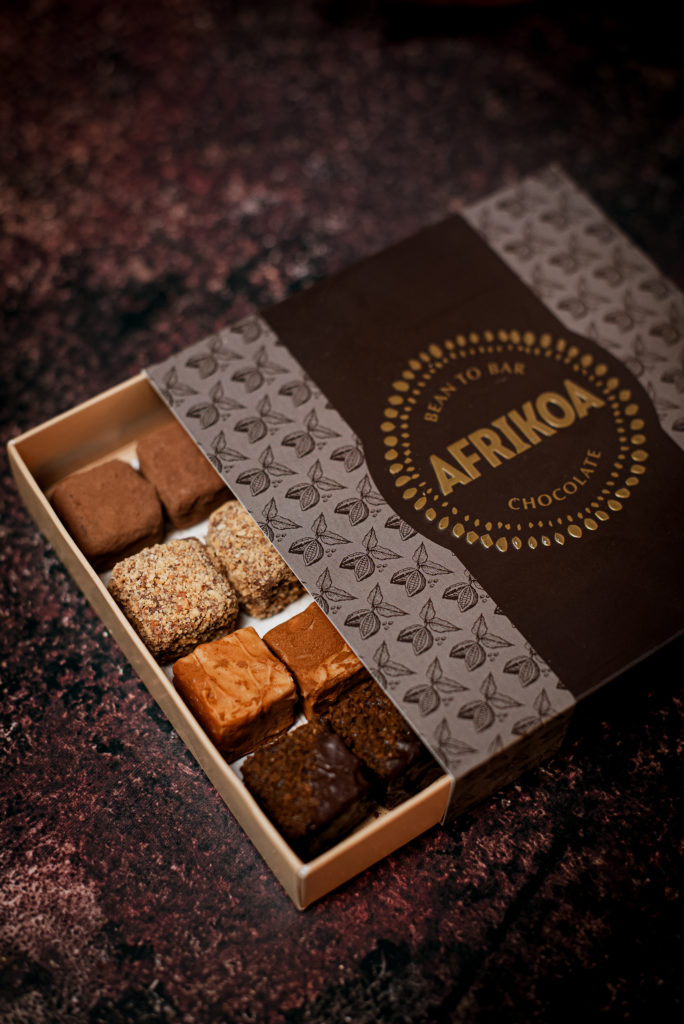Ghana and the Ivory Coast contribute a big chunk of the world’s chocolate. Yet, farmers here only earn around $1 a day. We profile entrepreneurs and chocolatiers determined to make sure the practice of cultivating cocoa prevails and it’s a sweet deal for the producers too.
British author Roald Dahl tapped into every chocoholic’s imagination when creating Willy Wonka’s bizarre chocolate factory in his 1964 children’s novel Charlie and the Chocolate Factory. Although the signature chocolate river may have been pure fantasy, Africa’s cocoa industry is being molded by real-life chocolate-makers who are making it their mission to demonstrate why the continent deserves a golden ticket.
“I’ve never seen anyone miserable while tasting chocolate. Even if you are miserable, you take a bite of chocolate and it boosts your mood. It makes people joyful. That’s part of its mystery and beauty,” believes Kimberly Addison, who, along with her sister Priscilla, started Ghana’s ’57 Chocolate in 2016.
The name of the Accra-based bean-to-bar company is inspired by the year in which the country gained independence and the spirit of developing a nation by manufacturing high-quality products.
Having spent her formative years in Switzerland’s second-most populous city, Geneva, Addison was accustomed to giving Swiss chocolate as gifts when visiting friends and family in the United States (U.S.), Senegal, and Ghana.
Loading...
“I was living in the chocolate nation of the world — or so I thought.”
Fulfilling her life-long dream of moving back to Ghana prompted her friends to take her on a farewell outing to a chocolate factory two weeks before her departure. It was during that tour that the seed of Addison’s life’s purpose began to cultivate.
“They had a display of where they sourced their cocoa beans from, and lo and behold, Cote d’Ivoire and Ghana were the two largest displays. I asked myself, ‘why on earth have I been taking Swiss chocolate everywhere I travel when the main ingredient comes from the continent of Africa? I should be bringing Ghanaian chocolate to Switzerland’.”
The only problem – Ghanaian chocolate didn’t really exist.
Although Ghana and Côte d’Ivoire are responsible for growing around 70% of the world’s cocoa beans, the raw material is most often exported to chocolate-producing countries in Europe and the U.S.
The lack of a locally-produced chocolate bar on the supermarket shelves of Côte d’Ivoire is what influenced Axel Emmanuel Gbaou to create his own. Not exactly the typical path for a banker with a master’s degree in taxation.
“There was no chocolate-maker in my country, even though we produce more than 2 million [metric] tonnes of cocoa per year. So, I decided to leave my job at the bank and rise to the challenge.”
Sourcing beans from Côte d’Ivoire’s seven cocoa farming regions, Gbaou has created mineral-rich, earthy blends that have won international awards, dispelling the myth that African-produced chocolate is not as good as that from global corporations like Nestlé and Mars.
“If you get good quality raw materials, half your job is already done,” says Kyle Hickman, head chocolatier at AFRIKOA in Cape Town, South Africa. The hand-crafted brand uses heirloom beans from Tanzania that are purchased from farmers through direct trade.
“Chocolate has to be refined to a point that it’s really smooth, down to 20 microns or less, so that our tongue cannot pick up any texture. It then goes through a process called conching where we get rid of a lot of the volatile notes, because chocolate can be very acidic if it’s not processed properly.”
The chocolate is then tempered to allow the fat crystals to set, and other elements like cocoa butter; sugar; milk powder; and flavorings are added in. South African rooibos tea and Rwandan coffee can be found amidst AFRIKOA’s wares, while ’57’s collection features flavors like hibiscus and moringa.
“It’s so easy to just break a bar, pop a piece in your mouth and enjoy it because chocolate is a food that brings people together and makes you smile, but I never in a thousand years knew how hard it is to make,” admits Addison who learned the process by spending a month with a chocolate-making couple in England before returning to Accra to teach others.
“Isn’t it ironic that I had to go outside of the continent to get training in chocolate-making, only to bring it back? Ghana is the second-largest producer of cocoa, yet we don’t really have any formal schools or technical training centers on how to work with this major resource of ours.”
A third of the globe’s cocoa farmers reside in parts of West Africa, though cocoa is not something that ever found a place in the local diet. The majority of cocoa growers have never even seen a piece of chocolate, let alone taken a bite.
“Cocoa was introduced during the colonial period and was cultivated from the beginning to be exported,” explains Michael E. Odijie, a research associate at University College London. “It was not introduced as a food crop that later became a cash crop; it was introduced as a cash crop right away. People cultivating cocoa in the late 19th century had no idea what the use for this crop was, but they understood that after harvest, there was always somebody willing to buy it.”
Despite being integral to the chocolate production process, farmers rarely receive their due. A shortfall in the most recent harvest, thanks to various factors such as climate change, diseased trees, and lack of investment, have resulted in cocoa prices soaring from $2.60 per kilogram at the beginning of 2023 to around $9.80 in July 2024. Yet, farmers are still only earning around $1 a day.
“There is a power imbalance between cocoa farmers at one end of the value chain and multinationals at the other end,” Odijie notes. “Farmers don’t have control over price which is basically set by demand and supply. A cocoa farmer in a village in Ghana does not have the capital, the information, the research to properly negotiate with the other end of the value chain.”

The lack of feasible income, in some cases, results in an inability to pay workers, thus leading farmers to resort to child labor.
“Child labor is defined by the International Labour Organization as work that deprives children of their childhood, their potential and their dignity, and that is harmful to their physical and mental development. This can include carrying heavy loads, using sharp tools like machetes to harvest the cocoa, or when the work interferes with the child’s schooling,” explains the Communications Director of the International Cocoa Initiative, Katie Bird.
The role of the NPO is to work with farmers, civil society organizations, and policymakers to tackle the issue of child labor and trafficking in West Africa where around 1.5 million children are reportedly affected. Raising awareness, improving access to quality education, building classrooms, providing books and uniforms, cash injections, and focusing on gender equality are some of the means the initiative has employed to combat the issue.
Bird notes: “Advancing women’s economic empowerment, helping them to participate in household decision-making can be very useful. There is usually more investment into the children’s schooling when the women have more of a say in the household decision-making.”
While the men work the field, Gbaou has taken it upon himself to share skills with the wives, mothers, and daughters of the communities, so they, too, may have a hand in shaping their future. “I have trained more than 2,000 women throughout Africa,” he reveals. “In the past, they did not know what to do with the beans, but now some make chocolate spread that they can sell to the children in the village. I train them how to make things with cocoa butter like soap and lipstick. It brings them some economic freedom.”
Addison agrees: “We’ve learned that the best investment one can make is in another human being, so our goal is that whoever comes through our door at ’57 must leave here better than they came.”
It is also about ensuring that the practice of cultivating cocoa prevails.
“They often say that the next generation of cocoa farmers don’t exist. And honestly, sometimes I even want to say that the next generation of farmers in general don’t exist. So now the challenge is how do we make farming interesting for young people?”
Much like its cocoa beans, the Ghanaian chocolatier hopes that Africans will remain on the continent.
“Africa shouldn’t be a place that we leave; it should be a place where people want to come to. Yes, it has its issues, its challenges, but where there are problems there are opportunities to begin to make changes. There’s no need to seek greener pastures elsewhere, we can create our own here.”
Choc-ful of potential, Africa is no longer simply clocking in to the chocolate factory — it’s building its own and inviting the world inside for a taste.
Loading...
